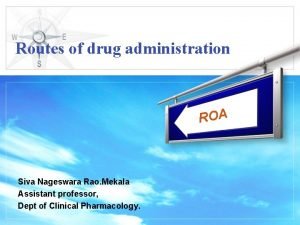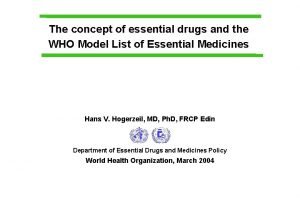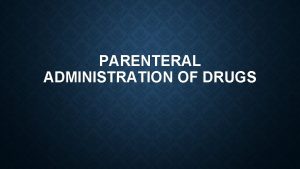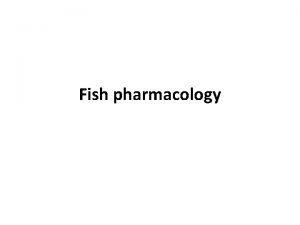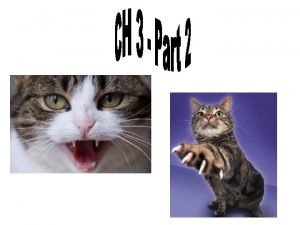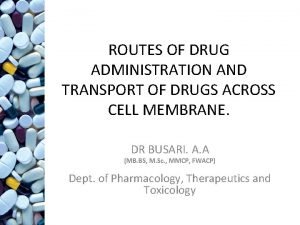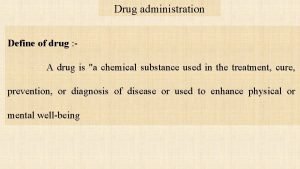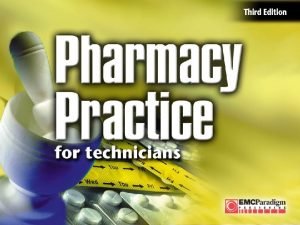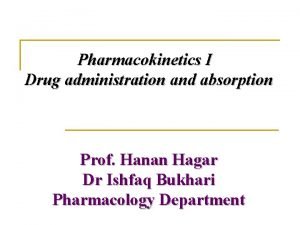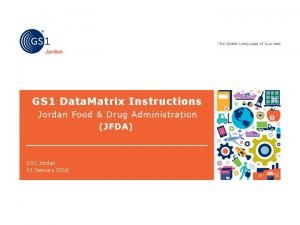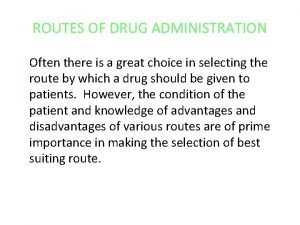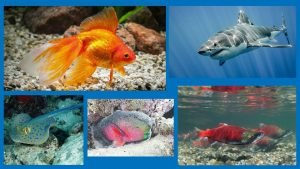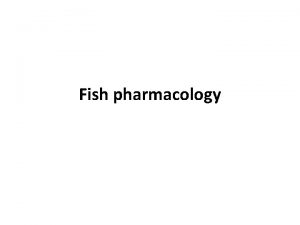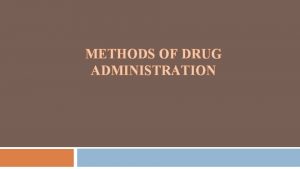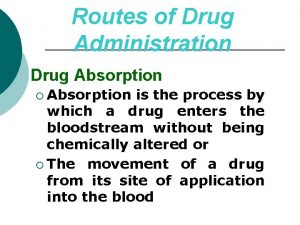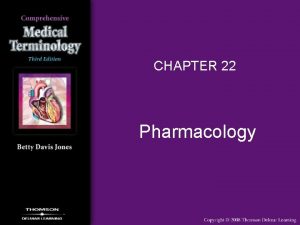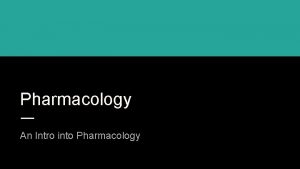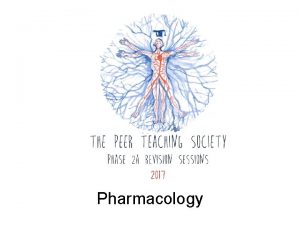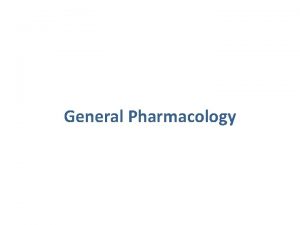FISH PHARMACOLOGY TOPIC ROUTES OF DRUG ADMINISTRATION Mr




















- Slides: 20

FISH PHARMACOLOGY TOPIC: ROUTES OF DRUG ADMINISTRATION Mr. Bhartendu Vimal Guest faculty-Asst. Prof. Co. F, Kishanganj, BASU, Patna

INTRODUCTION • Fish pharmacology is essential for undertaking treatment of fishes using any therapeutic and chemicals or drugs. • Before recommending any medicine to treat the fish diseases the following factors should be considered: a) Water quality b) Pathogens c) Fish mortality rate d) Legal issues e) Economics of treatment

ROUTES OF DRUG ADMINISTRATION

ROUTES OF DRUG ADMINISTRATION Water medication • This is the commonest method • Drug administered to the fish by medication of water in which the fish inhabits Merits • It is adaptable to mass medication of large numbers of fish

IMMERSION OR DIPPING • The preparation of small volume of medicated water in a separate container from that holding the fish • The fish, usually held in the net, are immersed in it for a short period of time and then returned to their normal environment Advantage • Use of certain antibacterial drugs in aquaria where filters are used to effect the bacterial oxidation of ammonia to nitrites and nitrates Disadvantage • Fish are exposed to the stresses of chasing, handling and netting

HYPEROSMOTIC INFILTRATION • HI is development of immersion designed to accelerate the absorption of macromolecules or even of particles such as antigenic bacteria • It primarily consists of two solution. • 1 st animal is dipped into a pharmacologically inert solution, hypertonic to fish plasma followed immediately by the solution to be absorbed.

FLUSHING • Here fish are kept in running water which is not recirculated, for example in a raceway, immersion can be achieved by flushing, or, as process sometimes called, a California flush • Flushing is more wasteful, and hence more environmentally polluting than dipping • It may be difficult to obtain a homogenous distribution of the medication in water

BATH TREATMENT • In bathing the bottom of the net cage is raised, typically to 2 meters, thus limiting the volume of water to be medicated • This reduces the weight of drug required and hence reduces both the cost and degree of environmental contamination Disadvantage • Bath treatment is wasteful and environmentally contaminating • Labour-intensive

ORAL/ENTERAL MEDICATION In-feed medication • Less wasteful method of administration than water medication • In-feed medication is standard practice for a large number of diseases but it is more prophylactic than therapeutic Pelleted medicated feed • The ideal way to medicate feed is to add the medicinal product to the feed-mix prior to pelleting

Surface coating pelleted feed • This process is suitable to the medication of small batches of feed and can be used for drugs which are heat-labile. • It is therefore the normal means of medicating feed on fish farms Spray-medication of pelleted feed • Sex hormones are important examples of a class of drugs which are, for practical purposes, insoluble in water and which are used in very small doses.

LEACHING • Leaching of drug into the water occurs with all forms of in-feed medication but is a particular problem associated with surface-coated feed. • Extent of leaching varies according to the water solubility of the active ingredient and time for which the feed remains in the water • The smaller the pellets the faster will be the leaching

MICRO-ENCAPSULATION OF DRUGS • One established method to make micro capsule structure is to use a calcium alginate core into which the drug is mixed and a chitosan-alginate shell • Whether a micro-capsule is retained in the stomach or not, largely question of its size

ARTEMIA ENRICHMENT • To enrich Artemia cysts they are decapsulated and placed in seawater which has been pre-sterilized by UV light and is well oxygenated Disadvantage • Only healthy fish can be treated • In addition it is extremely wasteful and costly affair

GAVAGE • Gavage is a form of oral administration extensively used in experimental work • It is rarely used in routine fish management as it is labour intensive and stressful to the fish. • A few fish such as brood fish or valuable ornamentals have to be dosed orally

INJECTION • Intramuscular injection • Intraperitoneal injection • Injection into dorso-median sinus • Automatic injectors • Machine injection

IMPLANTATIONS • Implantations may be intramuscular or intraperitoneal • Prolonged medication with a drug • It is sometimes formulated with as a pellet or capsule for implantation

TOPICAL APPLICATION • Topical applications of drugs in fish is rare; • where it is done it is usually for the treatment of skin ulcers on valuable ornamental fish

DRUG METABOLISM IN FISH • The detoxification of all drugs and chemicals in fish is carried out by liver • The rate is metabolism is about one tenth of that mammals. • Temperature optimum for many of the phase I reaction (oxidation, reduction, hydrolysis) and phase II reactions (conjugate formation and subsequent excretion) in fish is close to temperature of the natural environments of the fish

PHARMACOKINETICS • Fish being poikilothermic has an influence on its metabolic rate and activities by differences in water temperature resulting in pharmacokinetic complexity than in other vertebrates. • Reduced water temperature: slow metabolic rate causing slower drug absorption, metabolism and excretion and consequently longer withdrawal period • Predicted change in the environment of fish over a period of weeks following treatment must be considered carefully when planning the treatment

• Withdrawal period and Maximum residual limit: the withdrawal period is the amount of time required following the administration of last treatment for measurable residues of the drug or a metabolite to decrease to below an established safe level. This safe level is MRL, or tolerance • Degree days are calculated by adding the mean daily water temperature in 0 C for total number of days measured. At higher optimum temperature for the fish, the required degree days could be achieved in less number of days.
 Advantages and disadvantages of drugs
Advantages and disadvantages of drugs Roa drug
Roa drug One fish two fish red fish blue fish ride
One fish two fish red fish blue fish ride Scale types fish
Scale types fish One fish two fish blowfish blue fish
One fish two fish blowfish blue fish Concept of essential drugs
Concept of essential drugs What does parenteral route mean
What does parenteral route mean Fish pharmacology
Fish pharmacology Non parenteral route
Non parenteral route Oral route advantages
Oral route advantages Drug administration definition
Drug administration definition Local route of drug administration
Local route of drug administration Factors affecting choice of route of drug administration
Factors affecting choice of route of drug administration Advantages of iv route of drug administration
Advantages of iv route of drug administration Jordan food and drug administration
Jordan food and drug administration Intraperitoneal route advantages and disadvantages
Intraperitoneal route advantages and disadvantages Exhausted drug meaning
Exhausted drug meaning Lead paragraph example
Lead paragraph example Narrowing down a topic exercises
Narrowing down a topic exercises Cartilaginous fish vs bony fish
Cartilaginous fish vs bony fish A big fish swims up and swallows a small fish at rest
A big fish swims up and swallows a small fish at rest

